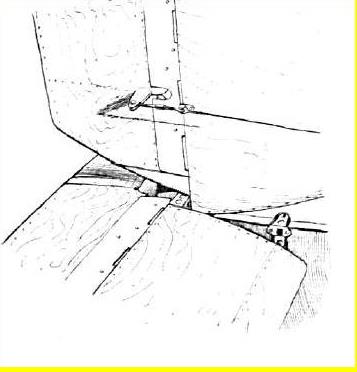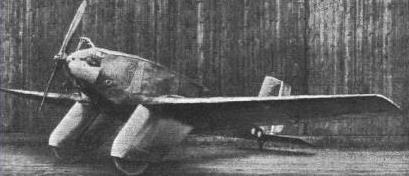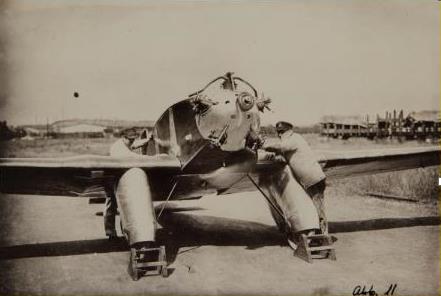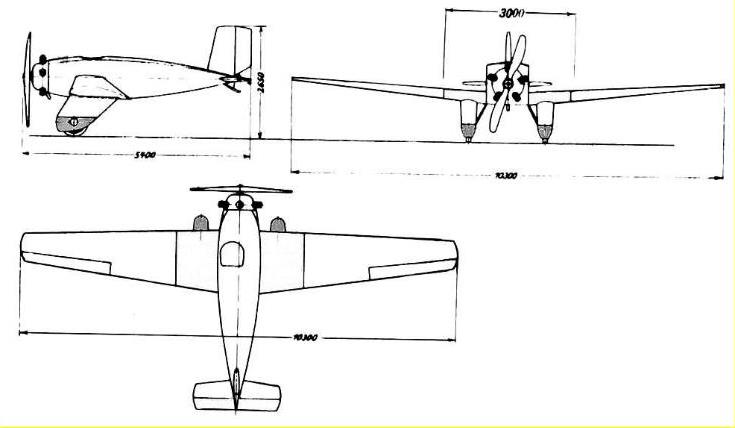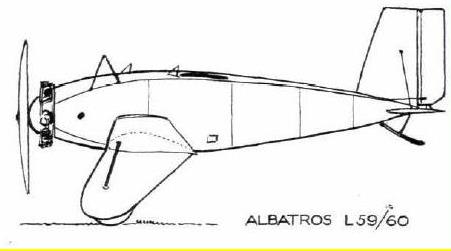Among the firms who were to have exhibited machines at the Gothenburg International Aero Exhibition was the Albatros-werke A.G.. of Berlin-Johannisthal. Unfortunately, complications over which the firm had no control prevented the machines from being sent, and thus I.L.U.G. was deprived of at least two interesting machines. One of the Albatros machines that were to have been shown was the type L.58 monoplane passenger carrier, but as this was described and illustrated in Flight on October 12, 1922, we have thought that a reierence to the other type which had been got ready lor the exhibition would be of more interest.
The Albatros sporting type is produced in two slightly dissimilar models : one. known as the type L.59, is a single- seater, with 50-60 h.p. Siemens radial engine, and the other is a two-seater, with a 90-100 h.p. engine of the same make, its series number being L.60. The two models are, generally speaking, of the same outline design, but certain differences arise out of the fact that the one has an extra seat and a larger engine. The machine illustrated in the accompanying photographs is the single-seater, type L.59, but the following description, except when otherwise stated, refers to both models.
Reference has been made in Flight to the effect which Inter-Allied restrictions on German aircraft production has had on modern German design. Debarred from constructing large machines, or. more correctly, machines with powerful engines, German designers have been obliged to design for aerodynamic efficiency, so as to attempt to improve this to the point where the smaller engine will give the same performance. Although this is no easy task, and cannot be said to have been quite accomplished, there is no doubt the several German aeroplanes of recent date do show evidence of a serious endeavour to get away from stagnation in design.
In most cases the line of development appears to have been the elimination of all avoidable head resistance such as struts, bracing wires, etc. In some German types, in fact in most, the result has been a cantilever monoplane, although the Caspar U.I exhibited at Gothenburg provides an example of the pure cantilever biplane. Some of the German designers favour the high wing position, others the low. The Albatros sporting types belong to the latter class, or " Tiefdeckers," as they call them. Although slightly less efficient aero- dynamically than the " high-decker," the low wing position has certain structural advantages that help to counteract the slightly lower efficiency. Also, the low position of the wing facilitates undercarriage design in that the tips of the wings are closer to the ground and should thus help to prevent overturning. In a monoplane with the wing resting on top of the fuselage a very wide wheel track seems to be called for, and it is almost useless to fit wing tip skids, as the machine would heel over so far as to cause the wing tip to touch at a sharp angle. In the Albatros sporting type the designers have gone one step further, and have mounted the undercarriage not on the fuselage at all, but on the wing roots. This arrangement has obviously been chosen because not only does a wide wheel track result, but, owing to the fact that the undercarriage members are vertical, the wheels can be partly enclosed in the streamline fairing surrounding each "leg." These " trousers" are well shown in one of the accompanying photographs.
The wing is constructed entirely in wood, and is planked with three-ply. In order to facilitate transport it is built in three sections, the centre section remaining in place and carrying the undercarriage. The wing is a pure cantilever, there being no external bracing whatever.
In the fuselage the usual Albatros construction has been employed. It may be recollected that in 1914 an Albatros biplane was flown in this country by Herr Robert Thelen, and that already in those days the Albatros designers favoured the all-wood fuselage, consisting of a light skeleton of formers and longerons, covered with thin three-ply wood.- The same construction characterises the latest Albatros monoplanes, and certainly appears to have the advantage of keeping its shape without the attention required by the wire-braced type. The Siemens radial air-cooled engine is neatly cowled-in, and is supplied with petrol from a tank mounted under the pilot's cockpit, inside the wing root. Sufficient fuel is carried for a flight of 3,5 hours' duration at full power.
The type L.59 is. as already mentioned, fitted with a 60 h.p. engine, and the L.60 with a 90-100 h.p. Siemens. The total loaded weight of the L.59 is 480 kgs. the load carried consisting of pilot, 75 kgs. , and 3,5 hours fuel. In the case of the L.60 the total loaded weight is 600 kgs., and the useful load consists of pilot, passenger, and 81 kgs. of petrol. The L.59.has a maximum speed at 1000 m. of 140 km. and the L.60 does 145 km. at the same altitude. The climb to 1.000 m. occupies 9 mins. in the case of L.59, and 8 mins. for the L.60. No figures relating to landing speed are available. The overall dimensions of both types are: Length, o.a., 5,4 m. span, 10,3 m. ; height. 2,65 m.
| Type |
Single-seat sportpla |
| Engine |
1 Sh 4 |
| Dimensions |
Length 5.40 m, height 2.65 m, span 10.30 m, wingarea 10.0 m2, aspect ratio 8.5 |
| Weights |
Empty 353 kg, flying weight 485 kg, fuel 57 kg |
| Performance |
Max. speed 150 km/h, service ceiling 3000 m, range 525 km, endurance 3.5 h, climb to 1000 m 9 min. |
| Type |
Werk.Nr |
Registration |
History |
|
10007 |
D-632 |
|
